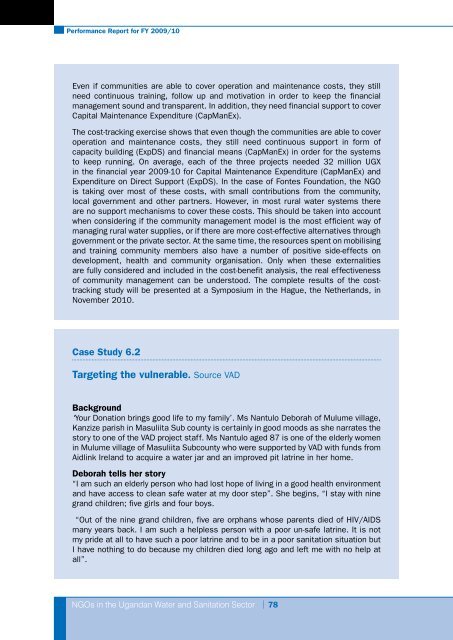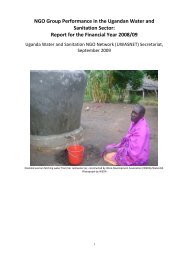Performance Report for FY 2009/10 - UWASNET
Performance Report for FY 2009/10 - UWASNET
Performance Report for FY 2009/10 - UWASNET
You also want an ePaper? Increase the reach of your titles
YUMPU automatically turns print PDFs into web optimized ePapers that Google loves.
<strong>Per<strong>for</strong>mance</strong> <strong>Report</strong> <strong>for</strong> <strong>FY</strong> <strong>2009</strong>/<strong>10</strong><br />
Even if communities are able to cover operation and maintenance costs, they still<br />
need continuous training, follow up and motivation in order to keep the financial<br />
management sound and transparent. In addition, they need financial support to cover<br />
Capital Maintenance Expenditure (CapManEx).<br />
The cost-tracking exercise shows that even though the communities are able to cover<br />
operation and maintenance costs, they still need continuous support in <strong>for</strong>m of<br />
capacity building (ExpDS) and financial means (CapManEx) in order <strong>for</strong> the systems<br />
to keep running. On average, each of the three projects needed 32 million UGX<br />
in the financial year <strong>2009</strong>-<strong>10</strong> <strong>for</strong> Capital Maintenance Expenditure (CapManEx) and<br />
Expenditure on Direct Support (ExpDS). In the case of Fontes Foundation, the NGO<br />
is taking over most of these costs, with small contributions from the community,<br />
local government and other partners. However, in most rural water systems there<br />
are no support mechanisms to cover these costs. This should be taken into account<br />
when considering if the community management model is the most efficient way of<br />
managing rural water supplies, or if there are more cost-effective alternatives through<br />
government or the private sector. At the same time, the resources spent on mobilising<br />
and training community members also have a number of positive side-effects on<br />
development, health and community organisation. Only when these externalities<br />
are fully considered and included in the cost-benefit analysis, the real effectiveness<br />
of community management can be understood. The complete results of the costtracking<br />
study will be presented at a Symposium in the Hague, the Netherlands, in<br />
November 20<strong>10</strong>.<br />
Case Study 6.2<br />
Targeting the vulnerable. Source VAD<br />
Background<br />
‘Your Donation brings good life to my family’. Ms Nantulo Deborah of Mulume village,<br />
Kanzize parish in Masuliita Sub county is certainly in good moods as she narrates the<br />
story to one of the VAD project staff. Ms Nantulo aged 87 is one of the elderly women<br />
in Mulume village of Masuliita Subcounty who were supported by VAD with funds from<br />
Aidlink Ireland to acquire a water jar and an improved pit latrine in her home.<br />
Deborah tells her story<br />
“I am such an elderly person who had lost hope of living in a good health environment<br />
and have access to clean safe water at my door step”. She begins, “I stay with nine<br />
grand children; five girls and four boys.<br />
“Out of the nine grand children, five are orphans whose parents died of HIV/AIDS<br />
many years back. I am such a helpless person with a poor un-safe latrine. It is not<br />
my pride at all to have such a poor latrine and to be in a poor sanitation situation but<br />
I have nothing to do because my children died long ago and left me with no help at<br />
all”.<br />
NGOs in the Ugandan Water and Sanitation Sector | 78



